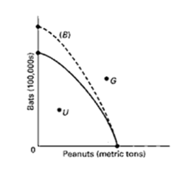(a) Explain the relationship between full employment of resources and full production.
(b) Look at the following production possibilities curve illustrating the possibilities in Sluggerville for producing bats and/or peanuts with the existing level of resources and technology.

i. Show a point U that would indicate unemployed resources in Sluggerville
ii. Draw a new curve B that illustrates the results of improved technology in the production of batsbut no change in the production efficiency of peanuts.
iii. Show a point G that would indicate a point that is currently unattainable in the production opeanuts and bats in Sluggerville.
(c) Below are four statements. Each of them is an example of one of the pitfalls often encountered in the study of economics. Indicate following each statement the type of pitfall involved.
i. “July is the month with the most ice cream sales and also the month with the most drownings.Therefore, the more ice cream people eat, the more likely they are to drown.”
ii. “Dry weather in the county where Farmer Brown lives decreased his income because his cropwas so poor. Therefore, when there is dry weather in the nation as a whole all farm incomes will suffer.”
iii. “I have to live within my income. Therefore, governments should not be allowed to borrow money.”
iv. “National health insurance plans are socialistic.
v. “People arrive at a soccer pitch and then players come on the field. Therefore, crowds instadiums cause soccer to be played.”
Question 2
(a) Suppose you invested $500 at 2.5%. How much money would you have at the end of years 1, 2, 5, 10, 20, 50, and 100 assuming you left the money in the bank to earn compound interest?
(b) Suppose Bertha buys a bungalow for $250,000. She expects she can either rent it out at $2,000/month, or with $15,000 invested in improvements, she expects to sell it for $305,000. What is Bertha’s expected rate of return in each scenario.
(c) Suppose you are faced with two options. Option A has a probability of 0.75 of earning 14% and a probability of 0.25 of earning 4%. Option B has a probability of 0.55 of earning 13% and a probability of 0.45 of earning 8%. Both options have a beta value of 1.25. Which option is an investor more likely to choose?
Question 3
(a) Describe three ways that the division of labour contributes to society's output.
(b) Explain this quote from Adam Smith: “It is not from the benevolence of the butcher, the brewer, or the baker that we expect our dinner but from their regard to their own interest.”
(c) What is the relationship between businesses and households in the circular flow model?
Question 4
(a) Suppose a producer sells 1,000 units of a product at $5 per unit one year, 2,000 units at $8 the next year, and 3,000 units at $10 the third year. Is this evidence that the law of demand is violated? Explain.
(b) Newspaper item: “Due to lower grain prices, consumers can expect retail prices of choice beef to begin dropping slightly this spring with pork becoming cheaper after midsummer,” the Agriculture Department predicted. “This reflects increasing supply,” the department said. Is the term “supply” used correctly? What effects might this announcement have on consumer demand? Explain.
(c) Determine the equilibrium price and quantity for the following situation. Demand is represented by the equation, P=20-.3QD and supply by the equation P=4+.2QS.